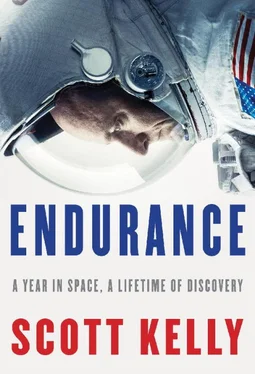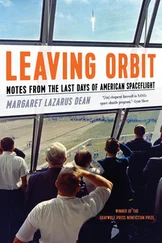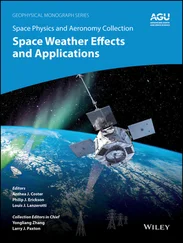Once I’m about halfway through the hatch, though, I have a transition in perspective. Suddenly I have the sensation of climbing up, as if out of the sunroof of a car. The large blue dome of Earth hovers over my head like some nearby alien planet in a sci-fi film, looking as if it could come crashing down upon us. For a moment, I’m disoriented. I’m thinking about where to look for the attachment point, a small ring where I will hook my safety tether, but I don’t know where to look for it.
Like any highly trained pilot, I know how to compartmentalize, to push thoughts out of my mind that aren’t helping me to complete the task at hand. I focus on what is immediately in front of me—my gloves, the handrail, the small labels on the outside of the station I’ve familiarized myself with through countless hours of training—and ignore the looming Earth above and the feeling of disorientation it creates. I don’t have time for it, so I set it aside and get to work. I take the hook from my safety tether off my mini-workstation, a high-tech toolholder attached to the front of my spacesuit, and secure it to one of the rings just outside the airlock, checking to make sure the hook is in fact closed and locked with complete certainty. Like putting an airplane’s landing gear down before landing, this is one of those things you absolutely do not want to screw up.
During my last long-duration mission on ISS, two of the Russian cosmonauts, Oleg Skripochka and Fyodor Yurchikhin, did a spacewalk together to install some new equipment on the outside of the Russian service module. When the two of them came back inside, they both looked shaken, Oleg especially. I assumed at first his reaction was to being outside for the first time, and it wasn’t until this yearlong mission that I learned all the details of what had happened that day: during their spacewalk, Oleg had become untethered from the station and started to float away. The only thing that saved him was hitting an antenna, sending him tumbling back toward the station close enough to grab on to a handrail, saving his life. I’ve often pondered what we would have done if we’d known he was drifting irretrievably away from the station. It probably would have been possible to tie his family into the comm system in his spacesuit so they could say good-bye before the rising CO 2or oxygen deprivation caused him to lose consciousness—not something I wanted to spend a lot of time thinking about as my own spacewalk was approaching.
The U.S. spacesuits include simple propulsive jets we could use to maneuver ourselves in space in case our tether breaks or we screw up, but we would not want to rely on them or, truth be told, try them out at all. The only way we practiced using the jet packs during our training was with virtual reality simulations, during which astronauts sometimes ended up running out of fuel or missing the space station altogether. I’m acutely aware that if I become detached and run out of fuel and the station is just one inch from my glove tips, it may as well be a mile. The result will be the same: I will die.
Once I’m certain my tether is secured, I remove Kjell’s tether from me and attach it to the outside of the station as well, being just as careful to double-check it as I was with my own. Kjell starts handing me bags of equipment we will need for our work, and I secure each of them to the circular handrail outside the airlock. Once we have everything we need, I give Kjell the go to exit. The first thing we do once we are both outside is our “buddy checks,” looking over each other’s suits from head to toe making sure everything is in order. Tracy talks us through it from mission control, telling me step-by-step how to check Kjell’s PLSS (portable life support system, the “backpack” we wear with the spacesuit) for signs of water having frozen in the sublimator. It looks completely normal—there are no snowflakes, I’m happy to report to the ground. Kjell and I both breathe a sigh of relief. Our spacewalk will proceed. (Later we would learn that some of the engineers wanted to call off the spacewalk and the lead flight director overruled them.) We go over each other’s helmet lights, helmet cameras, mini-workstations, jet pack handles, checking to make sure everything is properly stowed. One of Kjell’s jet pack handles is not—it was partially deployed while Kjell was on his way out of the airlock—and one of mine was as well. After fixing them, we check our tethers one more time. You can’t be too careful with tethers. Nearly five hours after getting into our spacesuits, we are ready to get to work.
—
FOR NEARLY as long as human beings have been going into space, we have been determined to climb out of the spacecraft. It’s partly just to achieve the fantasy of a human being floating alone in the immensity of the cosmos, nothing but an umbilical connecting him or her to the mother ship. But spacewalks are also a practical necessity for exploration. The ability to move from one spacecraft to another, to explore the surfaces of planetary bodies, or (especially relevant to the International Space Station) to perform maintenance, repairs, or assembly on the exterior of the spacecraft—all are crucial to long-term space travel.
The first spacewalk was carried out in 1965 by cosmonaut Alexei Arkhipovich Leonov. He opened the hatch of his Voskhod spacecraft, floated out on an umbilical, and reported to Moscow: “The Earth is absolutely round”—probably to the dismay of flat-earthers everywhere. It was a triumphant moment for the Soviet space program, but after twelve minutes, Alexei Arkhipovich found that he could not get back through the hatch. Due to a malfunction or poor design, his spacesuit had inflated to the point that he could no longer fit through the narrow opening; he was forced to let some of the precious air out of his suit in order to struggle back through. Doing so caused the pressure to drop so much he nearly passed out. This was not an auspicious beginning to the history of spacewalks, but since then more than two hundred people have successfully suited up to float out an airlock into the blackness of space.
While some of the challenges of spacewalks have gotten easier, they are no less dangerous. Just a few years ago, astronaut Luca Parmitano’s helmet began filling with water while he was outside, raising the terrifying specter of an astronaut drowning in space. Spacewalks are much riskier than any other part of our time in orbit—there are so many more variables, so many pieces of equipment that can fail and procedures that can go wrong. We are so vulnerable out there.
As pilot and commander of the space shuttle, I never had the chance to do a spacewalk. The mission specialists went through the hundreds of hours of training necessary to work outside the spacecraft while I trained to fly and command the mission. For most of the shuttle era, those of us designated as pilots knew that, because of this division of labor, we would never have the chance to put on a spacesuit and float out into the cosmos. A shuttle could return safely with a missing or injured mission specialist, but a missing pilot or commander would be much more problematic. But we are now in another era of spaceflight, and this mission on ISS has given me the chance.
Getting ready to go outside takes a great deal of time. We plan in advance as thoroughly as we can what we will do and in what order, to minimize problems and to maximize efficiency and performance. We prepare the suits, check and double-check all of the components that will keep us alive in the vacuum of space, and organize and prepare the tools we will use—custom-designed for use in zero gravity with our bulky gloves.
I’ve been up since five-thirty this morning and have been hurrying to stay ahead of the timeline all day. I got into a diaper and the liquid cooling garment we wear under the spacesuits, like long underwear with built-in air-conditioning once it’s connected to the suit. Then I ate a quick breakfast I’d laid out the night before to save time and made my way to the airlock to start getting suited up. My goal was to be out of the airlock early—my philosophy is that for complicated jobs, if you aren’t ahead of schedule, you’re already behind.
Читать дальше












